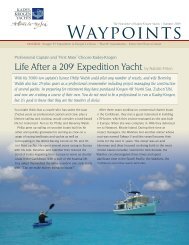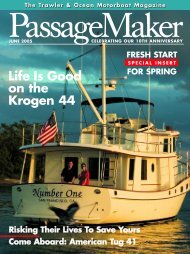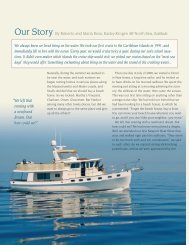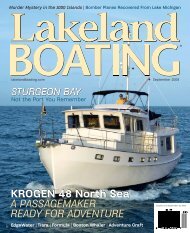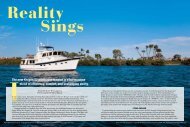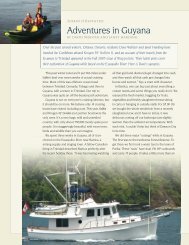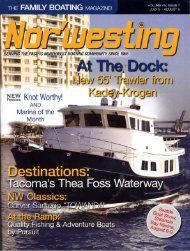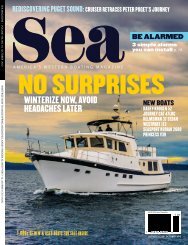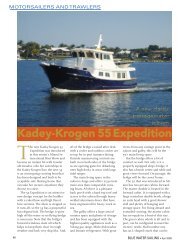44 Feet of Grace... A Kadey-Krogen Story - Kadey-Krogen Yachts
44 Feet of Grace... A Kadey-Krogen Story - Kadey-Krogen Yachts
44 Feet of Grace... A Kadey-Krogen Story - Kadey-Krogen Yachts
Create successful ePaper yourself
Turn your PDF publications into a flip-book with our unique Google optimized e-Paper software.
<strong>44</strong> FEETOFGRACEA <strong>Kadey</strong>-<strong>Krogen</strong> <strong>Story</strong>By Christine Bynum-Degenhe sound <strong>of</strong> thousands <strong>of</strong> gallons <strong>of</strong> water rushing through woodenslats isn’t something most boat owners enjoy hearing. But this day, Billvan Lenthe is relishing one <strong>of</strong> the few exceptions to this rule, as gears, leversand gravity lower his <strong>44</strong>-foot <strong>Kadey</strong>-<strong>Krogen</strong> through the Ijmuiden Locksand into Holland. Van Lenthe and his crew <strong>of</strong> four were nearing the end <strong>of</strong>their 26-day journey across the Atlantic, and the excitement in the salt-filled airwas palpable as they once again viewed van Lenthe’s place <strong>of</strong> birth, from wherehe had emigrated in 1965.Their adventure, which startedin North America, was inspirednearly six years earlier when vanLenthe, on a trip to Portugal, foundhimself standing at the westernmosttip <strong>of</strong> Europe, thinking: “Wouldn’tit be nice to glide into these westernEuropean shores, or perhaps aport in Holland, on my own boat.”It wasn’t until he and his wife werecompleting their 2006 voyage <strong>of</strong> theAmerican Great Circle loop in their530 Carver Voyager that his dreambegan to take shape, when he firstset eyes on a <strong>Kadey</strong>-<strong>Krogen</strong>. “It wasa reasonably low air draft, full-displacementtrawler,” van Lenthesaid. And though the Carver hadserved them well, it was not set upfor an Atlantic voyage. So the vanLenthes traded in their Carver andin the winter <strong>of</strong> 2007 they took delivery<strong>of</strong> the <strong>44</strong> <strong>Kadey</strong>-<strong>Krogen</strong> andchristened it Le rêve, which isFrench for “the dream.”Preparations now began inearnest from their home in Ontario,62 SEA / APRIL 2009
(top L-R) The crew <strong>of</strong> Le rêve led by Bill van Lenthe. The most difficult part <strong>of</strong> the crossing was enduring inclement weather. The crew faced up to 30-35-knotwinds and waves up to 18-feet at times. (bottom L-R) Drenthe is a province <strong>of</strong> northeast Netherlands and a welcome stop after making the grueling crossing.The picturesque town <strong>of</strong> Volendam, in North Holland, Netherlands has largely been unchanged since the 17th century.Canada. Van Lenthe knew thatalthough Le rêve was a sturdy boat,it was “a little small for doing thattype <strong>of</strong> trip.” After installing someadditional equipment he felt Le rêvewould be ready for their transatlanticvoyage.The two months preceding thetrip were the busiest and not withouta few near-misses. First on thelist <strong>of</strong> equipment to be installed wasa “get home” engine. Van Lenthedecided on a 2600 rpm, Nanni dieselengine, but became concerned whenthe delivery was four months late.The engine finally arrived and it wasinstalled in very short order. TheNanni was equipped with its own saildrive and folding prop, so it was trulyseparate from the main propulsionsystem and could be relied upon ifanything went wrong with the mainengine, drive shaft or propeller. Healso installed a larger alternator onthe main engine. The original alternator(a 150 amp) would be usedstrictly for charging the main enginestarting battery. The new alternator(a 270 amp) would be responsiblefor keeping the house bank batteriescharged.Modifications also had to bemade in order to hold the additionalfood they needed for such a longjourney. So, van Lenthe installed a64-quart freezer on the deck, aroundwhich he placed an aluminum boxthat was two and a half inches biggeron all sides than the freezer. Hefilled the space between the freezerand box with Styr<strong>of</strong>oam insulation,so that once the freezer waschilled to the correct temperature,the Styr<strong>of</strong>oam insulation made itpossible to use minimal power andstill keep everything cold.A Spectra water-maker wasinstalled in the engine room andextra storage boxes were installedon the bridge and in the cockpit,where they could double as seats.Keeping in mind they would be subjectto European electricity oncethey reached Holland, he installeda battery charger that would run onEuropean electricity. This batterycharger is hooked up to the housebattery bank and keeps these batteriescharged whenever electricityis available.SEA / APRIL 2009 63
StartAtlantic Highlands,New JerseyTotal days at sea 26Total hours at sea 612Total miles 3,885CrossingStatisticsThe crossing from AtlanticHighlands, New Jersey toIjmuiden, Holland was madein three legs.Note: 100 nm was added to the tripdue to inclement weather causingthem to move further south.Leg 1 Atlantic Highlands,New Jersey, U.S. to Horta on theIsland <strong>of</strong> Faial in the Azores.Leg 2 Horta to Plymouth,England.Leg 3 Plymouth to Ijmuiden,Holland.(L-R) The crew <strong>of</strong> Le rêve, Bill van Lenthe,Eugene Kohlmetz, Mike Lankes, BernNorfolk and Clyde Honeycutt paint theirinsignia on a dock in Horta keeping withlocal tradition.Leg 2Plymouth,EnglandLeg 1Faial, AzoresLeg 3Ijmuiden Locks,HollandFirst-leg StatisticsTotal distance2,150 nmTotal days 16Total hours at sea 391Total miles 2,250Average rpm 1,300Fuel681 gals.Average speed5.7 knotsAverage mpg 3.37Second-Leg Statistics(Horta to Plymouth)Total distance1,268 nmTotal days 7.5Total hours at sea 178Total miles1,268 nmAverage rpm 1,800Fuel524 gals.Average speed7.1 knotsAverage mpg 2.42Third-Leg Statistics(Plymouth to Ijmuiden)Total days 2.5Total hours at sea 53Total miles367 nmAverage rpm 1,750Fuel110 gals.Average speed6.9 knotsAverage mpg 3.3Van Lenthe obtained insurancethat covered them for an Atlanticcrossing. He also purchased flags <strong>of</strong>every country they would visit aswell as a quarantine flag. The quarantineflag would be raised beforeentering the waters <strong>of</strong> a foreign country,and once they cleared customsthe flag <strong>of</strong> that country would beraised.Finally, on June 6, 2008, workand provisioning was complete andvan Lenthe and crew, ClydeHoneycutt, Mike Lankes, BernNorfolk and Eugene Kohlmetz, setsail from Atlantic Highlands, NewJersey.The first leg <strong>of</strong> their adventurewas the longest: a 16-day cross-Atlantic dash to the Azores.The Azores is a group <strong>of</strong> nineislands under Portuguese rule; theport <strong>of</strong> Horta on the island <strong>of</strong> Faialis the most popular stop for boatersundertaking a transatlantic crossing.Horta is approximately 900 nm frommainland Europe, and it’s a goodplace to stop, refuel and provisionbefore continuing.From there they continued in anortheasterly direction, towardEngland. But before they left, in keepingwith Horta tradition, they madesure to paint their boat insignia onthe dock amid thousands <strong>of</strong> otherinsignias from seafaring travelers.The most difficult part <strong>of</strong> thecrossing was the inclement weather.“We only had about six decentdays <strong>of</strong> weather during the wholetrip. The rest was fairly blowy, rainyand foggy; up to 30-to35- knotwinds at times and waves up to 18feet,” van Lenthe recalled.But the continual storm didn’tseem to faze Le rêve. It glided gracefully,pushed on and stayed on thecourse that was plotted in the navigationalequipment. The crew andvan Lenthe were so impressed withthe boat’s ability to easily handleeverything that was thrown at it, thatthey compared it to a dancer.The <strong>Krogen</strong> was not the onlydancer among the waves, though.The crew <strong>of</strong>ten found themselves in64 SEA / APRIL 2009
the company <strong>of</strong> various types <strong>of</strong> sealife: pods <strong>of</strong> porpoises that would play<strong>of</strong>f the bow as well as mola mola(giant ocean sunfish). Just beforethey made landfall in Horta, a pod<strong>of</strong> whales was spotted <strong>of</strong>f the bowas if to welcome them to the Azores.These appearances, as well as theever-changing ocean, did much tokeep the voyagers entertained duringthe <strong>of</strong>ten relentlessly stormydays.They soon found that it would notbe all visual delights, though. Abouthalfway through their crossing andafter days <strong>of</strong> not seeing any otherProvisioningboats, they noticed a sailboat <strong>of</strong>f thestarboard side. It looked strange sothey altered course to investigate.Upon arriving on scene, they saw thesailboat’s mast was broken, thesails were furled up and the riggingwas hanging overboard. The cockpitdoors were open and the raft wasstill on the bow untouched.Maneuvering Le rêve closer wasn’tan option because <strong>of</strong> the weather andthe rigging hanging overboard. Thefear that there might still be peopleon the sailboat who were injured orin need <strong>of</strong> assistance was so distressingthat one <strong>of</strong> theHalfway through the crossing the crew came upona chilling sight, a stranded sailboat with a brokenmast and the rigging hanging over the side. One<strong>of</strong> many beautiful sunsets the crew <strong>of</strong> Le rêveenjoyed while at sea for 26 days. The crew wastreated to a Pod <strong>of</strong> porpoise that enjoyed playing<strong>of</strong>f the bow <strong>of</strong> the boat.crew wanted to swim over to the sailboatand check. But this was simplytoo dangerous. They repeatedlyattempted to hail the listing boatby radio and voice, but with noresponse. Eventually they pulledaway and contacted the UnitedStates Coast Guard, who informedthem that they had already rescuedHow do you go to a grocerystore when you’re thousands<strong>of</strong> miles from shore?The answer, you don’t.Provisioning for an extended trip isno small task. If you forget somethingthere’s no running to the grocerystore to pick up a few lastminuteitems.Start by creating a list <strong>of</strong> the types<strong>of</strong> items you think you’ll need. Inplanning the food it’s helpful to drawup a week’s worth <strong>of</strong> menus. Thinkabout all the items you’ll need to preparea meal including any necessaryutensils. This list should be a goodbase to build from when you actuallystart to provision the boat.Keep an eye out for foods thatwill stay fresh for extended periods<strong>of</strong> time, or are packaged for longevity.Cheese that is packaged in waxwill last a longer thancheese slices. Other foodssuch as salami, sausage andpepperoni that are kept in thenon-refrigerated section <strong>of</strong> themarket will stay fresh formonths.When choosing food pick itemsthat can serve double duty. Cannedtomatoes can be used for omeletsand also to make spaghetti sauce.Carrots are a great snack and caneasily be tossed into a salad to livenit up. By stretching your food useyou will lower the cost and savespace.Be careful what foods you decideto store together. They’re not alwayscompatible. Apples and carrotsstored together will <strong>of</strong>ten cause bitternessin the carrots. And if onionsare kept with potatoes, the onionswill rob thepotatoes <strong>of</strong>their moisture.It’s also a goodidea to purchasesome very simpleprepackaged meals. Ifthe seas are rough theboat galley may be an unworkableenvironment, prepackaged mealsthat require little more than heatingwill be handy.On board give careful considerationto where you store perishables.Storage lockers located closer to thehull and below the waterline will becooler and better for produce, especiallyif you boat in a humid, tropicalarea. While there is a lot to considerwhen provisioning for a longtermtrip, logical thought can reduceyour stress on launch day.SEA / APRIL 2009 65
the people and to continue on theirway. Le rêve’s crew was relieved, butremained in a more subdued frame<strong>of</strong> mind for the rest <strong>of</strong> the day.The sailboat incident remindedthem <strong>of</strong> what they were doing andhow vulnerable they were to thewhims <strong>of</strong> an unforgiving ocean.Although most crossings are completedin private sailboats, vanLenthe commented, “There areother relatively small trawlers thathave made the crossing; however,this is done in a flotilla <strong>of</strong> six or eightboats.” Le rêve and its crew had noother boats to rely on if somethingshould happened, there was no oneelse to help. This was no game, andvan Lenthe was glad he had takenextra precautions when preparing forthe trip.Soon, though, the mood lightenedas they again realized the incrediblejourney they were on, enjoyingthe astonishingly blue waters <strong>of</strong>the North Atlantic, the marine lifearound them and also ClydeHoneycutt’s incredible meals.Honeycutt had <strong>of</strong>fered to take on theresponsibility <strong>of</strong> provisioning andcooking for the trip, and the crewwas delighted with the outcome. “Weate like kings,” van Lenthe said.The crew took turns rotatingthrough the watch and captainingthe vessel. At times the quarters gota little cramped. Van Lenthe decidedthat four other people justweren’t necessary, and if he had todo anything differently, he wouldtake a crew <strong>of</strong> three instead <strong>of</strong> four.But card games and cribbage, listeningto music, talking and enjoyingLe rêve’s gentle sway kept thembusy; they were amazed at howThe Dream“Le rêve” means “the dream” inFrench and has historical familyvalue to van Lenthe’s wife, Joanne.When the Huguenot moved northfrom France, in order to escape persecution,one <strong>of</strong> the families settledon a farm in Holland and calledit Le rêve. Joanne’s family eventuallybought the farm, and thename (although somewhat altered)stuck. They called it “t,reve.” Thevan Lenthes heard the story at afamily reunion in Holland the yearthe <strong>Kadey</strong>-<strong>Krogen</strong> was being built,and they decided to call the boat“Le rêve”.Being on the ocean for anextended period <strong>of</strong> time with noaccess to medical help can be a verydangerous situation. So, van Lentheand the crew consulted with theirphysicians before they made thecrossing to be assured <strong>of</strong> good healthand have instructions on what todo in case <strong>of</strong> emergencies. Thankfullythey had to use seasicknessmedication only once during thetrip.There were many systems andequipment additions made to the<strong>Kadey</strong>-<strong>Krogen</strong>:Storm windows made from halfinchLexan and cut to be 2 incheslarger than the original windowswere installed, as well as a devicecalled a “Find Me Spot.” This isused to communicate via satellitewith up to 10 e-mail or cell phonetext messages. It also is used to letup to ten addresses know <strong>of</strong> theexact location <strong>of</strong> the boat. AnEPIRB (Emergency PositionIndicator Radio Beacon) was alsorented. A six-man Winslow life raftand satellite phone that would sendand receive texts was obtained. Andvan Lenthe set up a system withBob Jones, the weather router <strong>of</strong>Ocean Marine, to receive textmessages on his satellite phonewith weather information on a dailybasis.Before they departed, they metup with friends from Ontario,Le rêve means the dream in French. When theHuguenot moved north from France, in order toescape persecution, one <strong>of</strong> the families settledon a farm in Holland and called it Le rêve.Joanne van Lenthe’s (Bill’s wife) family eventuallypurchased the farm.Canada, who were in the middle <strong>of</strong>their trip around the AmericanGreat Circle. They came aboardLe rêve with a bottle <strong>of</strong> champagneto toast the pre-crossing.Le rêve has a full kitchen withan oven, stove and microwave,allowing their volunteer chef, ClydeHoneycutt, to cook daily feasts suchas steak, lobster, lasagna, meat andpotatoes, pork chops and sausages.“We ate better than at any restaurant,”van Lenthe said.66 SEA / APRIL 2009
quickly the days flew by.Soon they were gazing at theshores <strong>of</strong> England and made landfallin Plymouth. After exploringPlymouth for about three days theyleft on the last leg <strong>of</strong> their journey.Two and a half days later theIjmuiden Locks, and Holland, werebefore them.For all it had been a trip theywould never forget, but for some itwas the adventure <strong>of</strong> a lifetime. Thispoint was driven home, when twomonths and 11 days after theyarrived in Ijmuiden, EugeneKohlmetz died from a severe brainhemorrhage.The funeral was difficult.Kohlmetz was remembered as one<strong>of</strong> the most valuable members <strong>of</strong> thecrew; the diplomat and the encourager.Van Lenthe didn’t realize howmuch Kohlmetz enjoyed their tripuntil he saw all the pictures thatKohlmetz had taken and learnedfrom his family that he couldn’t stoptalking about their adventure.The <strong>Kadey</strong>-<strong>Krogen</strong> had done itsVolendam in North Holland, Netherlands is wellknownfor its fishingboats and the traditionalclothing still worn by inhabitants. Faial is aPortuguese island <strong>of</strong> the Central group (GrupoCentral) <strong>of</strong> the Azores.job well, transporting its passengersfrom one continent to another, withgrace and ease, allowing dreams tocome true and memories to be madethat would last forever.Le rêve now waits patiently in thewater, in a frost-free shed, inLeeuwarden, Holland for the nextgrand adventure.SEA / APRIL 2009 67



